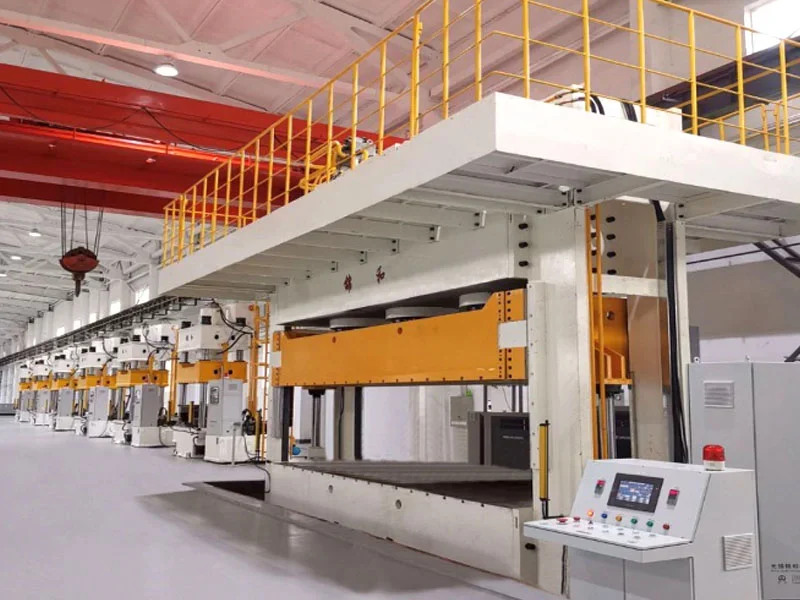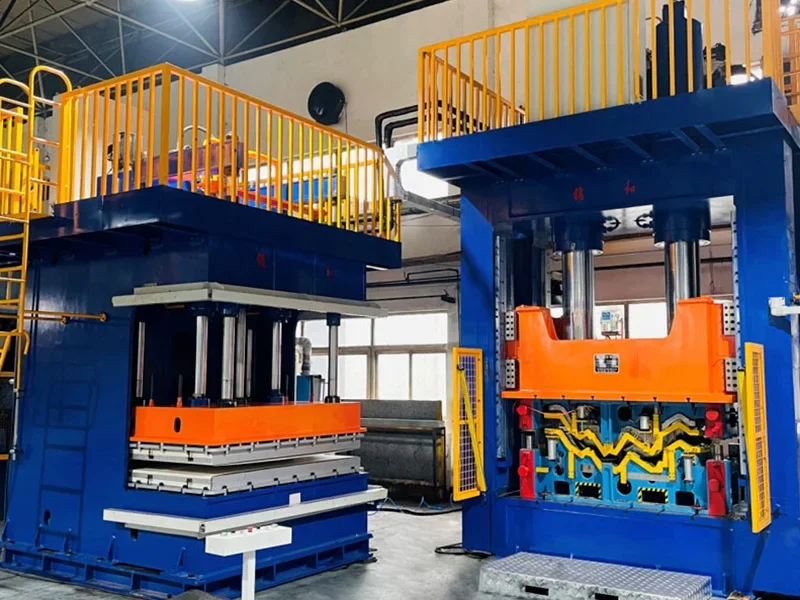How do compression molding presses differ from composite forming presses?
Can custom solutions be designed for specific requirements in composite press technology?
What key specifications should one consider when evaluating composite press options?
In which industries are composite presses commonly utilized?
Exploring the world of composite press unveils a realm where innovation and technology converge to redefine printing standards. This advanced form of press utilizes a combination of materials, enhancing durability and print quality like never before. From automotive industries to aerospace applications, composite press finds its utility across diverse sectors, promising efficiency and precision in every output. Understanding the nuances of composite press is crucial for businesses aiming to stay ahead in today's competitive market landscape. Dive into this blog post to unravel the intricacies of composite press technology and discover how it can elevate your printing processes to new heights.
Understanding Composite Presses and Their Functions
Shaping and Molding
Composite presses, also known simply as presses, are essential in shaping and molding composite materials. They utilize heat and pressure to transform raw materials into sturdy and long-lasting composite products. By applying the right amount of heat and pressure, composite presses can create a wide range of items used in various industries.
Composite presses are versatile machines that play a critical role in manufacturing processes across different sectors. These machines have the capability to shape composites into intricate designs with precision, ensuring high-quality end products. For example, in the aerospace industry, presses are used to manufacture lightweight yet robust components for aircraft.
Ensures precise shaping of composite materials
Enables the creation of complex designs
Produces high-quality products for various industries
Heat Application
One key function of composite presses is their ability to apply controlled heat during the molding process. This heat application softens the composite materials, allowing them to take on specific shapes under pressure. The temperature control feature ensures that the materials reach optimal flexibility without compromising their structural integrity.
In addition to shaping composite materials effectively, controlled heating by presses contributes significantly to enhancing product durability. By carefully regulating the temperature throughout the molding process, manufacturers can produce strong and resilient composite products suitable for demanding applications.
Facilitates material softening for shaping
Enhances product durability through controlled heating
Contributes to creating robust composite products
Different Types of Composite Molding Presses
Hydraulic Presses
Hydraulic presses are a common type of composite press that uses fluid pressure to generate compressive force. These presses are known for their high force capability, making them suitable for applications requiring high pressure and precision. Hydraulic presses are often used in industries like aerospace and automotive for manufacturing composite parts with intricate designs.
Hydraulic Presses:
High force capability
Suitable for precise applications
Common in aerospace and automotive industries
Hydraulic presses offer excellent control over the molding process, ensuring consistent results across production runs. However, they can be slower compared to other types of composite molding presses.
Electric Presses
Electric composite presses utilize electric motors to apply pressure during the molding process. These machines are known for their energy efficiency and quiet operation. Electric presses are ideal for applications where precise control over pressure and speed is crucial, such as in the electronics industry.
Electric Presses:
Energy efficient
Quiet operation
Ideal for precise control
One key advantage of electric composite molding presses is their ability to deliver fast cycle times while maintaining accuracy during part production.
Hybrid Presses
Hybrid composite molding presses combine features of both hydraulic and electric systems to optimize performance. By blending the benefits of each technology, hybrid presses offer enhanced flexibility, energy efficiency, and productivity. They are versatile machines suitable for a wide range of composite manufacturing processes.
Hybrid Presses:
Blend features from hydraulic electric systems
Enhanced flexibility energy efficiency
Versatile machines
The versatility of hybrid pressing technology allows manufacturers to adapt quickly to varying production requirements without compromising on quality or efficiency.
Compression Molding vs. Composite Forming Presses
Compression Molding Process
Compression molding presses apply pressure to composite materials using a vertical or horizontal press, shaping them into the desired form. This method involves placing the composite material in a heated mold cavity before applying pressure to compress it.
The advantages of compression molding include its ability to produce high-strength parts with complex geometries efficiently. It is commonly used for manufacturing products like automotive parts, aerospace components, and electrical insulators.
Pros:
Efficient production of high-strength complex parts
Suitable for various industries such as automotive and aerospace
Cons:
Longer cycle times compared to other methods
Initial tooling costs can be high
Composite Forming Presses
Composite forming presses use flexible membranes or bladders that come into direct contact force with the composite material and mold surface during the forming process. These presses are ideal for creating intricate shapes and structures.
One significant benefit of composite forming presses is their versatility in producing lightweight components with superior strength-to-weight ratios. They are often employed in industries requiring advanced composites such as sports equipment, marine vessels, and medical devices.
Pros:
Ability to create lightweight components with excellent strength
Ideal for intricate shapes and designs

Custom Designed Solutions in Composite Press Technology
Increased Efficiency and Productivity
Custom designed composite press solutions are tailored to meet specific manufacturing requirements, offering a range of benefits. These solutions can integrate specialized heating systems that precisely control temperature distribution across the heated platens, ensuring optimal curing of the resin. Moreover, unique mold configurations allow for the production of intricate parts with high levels of detail and accuracy.
Customization in composite press technology extends beyond physical components to encompass advanced control systems that regulate various parameters during the manufacturing process. By incorporating precise controls for pressure, temperature, and cycle times, manufacturers can achieve consistent part quality while maximizing operational efficiency. This level of customization enables companies to streamline their production processes, reduce waste, and enhance overall productivity.
Tailored solutions optimize heating system
Unique mold configurations enhance part precision
Advanced control systems improve process consistency
Quality Enhancement through Personalization
The ability to customize composite press technology results in a significant improvement in product quality within the composite manufacturing industry. By designing presses with specific features such as increased tonnage capacity or extended stroke lengths, manufacturers can produce larger components or molds efficiently without compromising on structural integrity or surface finish.
Furthermore, custom-designed solutions offer flexibility when working with a diverse range of materials and part geometries. Manufacturers can adapt their presses to accommodate varying material properties or complex shapes by adjusting parameters like platen size or tooling configuration accordingly. This adaptability ensures that each product meets stringent quality standards while allowing for rapid tool changes or repairs as needed.
Enhanced tonnage capacity for large components
Flexibility in accommodating diverse materials and shapes
Rapid tool changes ensure continuous production flow
Key Specifications and Control Systems of Composite Presses
Key Specifications
Composite presses come with various key specifications to ensure optimal performance. The tonnage capacity of a press determines the maximum force it can exert during the molding process. A larger tonnage capacity allows for the production of more robust and complex composite parts. Another crucial specification is the platen size, which dictates the maximum dimensions of components that can be manufactured in a single cycle.
Moreover, heating temperature plays a vital role in ensuring proper curing of composite materials. Controlled heating helps achieve consistent results and prevents defects in the final product. Efficient cooling capabilities are essential for rapidly cooling down components after molding, reducing cycle times and increasing overall productivity.
Tonnage capacity influences part complexity
Platen size affects component dimensions
Heating temperature ensures proper curing
Cooling capabilities reduce cycle times
Control Systems
Advanced control systems integrated into composite presses enable precise regulation of various parameters critical to the molding process. These systems provide accurate temperature control, maintaining ideal conditions for material curing and preventing overheating or under-curing issues that could compromise product quality.
Furthermore, sophisticated control mechanisms oversee pressure levels throughout each stage of production, ensuring uniformity across all molded components. By controlling these variables effectively, manufacturers can achieve consistent results with minimal deviation between parts.
Accurate monitoring and control not only enhance product quality but also lead to reduced waste by minimizing errors during manufacturing processes.
Temperature control ensures optimal curing conditions
Pressure regulation maintains consistency
Accurate monitoring reduces waste
Applications and Industries Served by Composite Presses
Diverse Industries
Composite presses play a crucial role in various industries like aerospace, automotive, marine, sports equipment, and construction. These industries rely on composite presses to create essential components for their products. For instance, in the aerospace sector, composite presses are used to manufacture aircraft parts like wings and fuselage sections.
In the automotive industry, composite presses are utilized to produce lightweight body panels that enhance fuel efficiency and overall performance. Similarly, in the marine industry, these presses are instrumental in crafting boat hulls that offer durability while maintaining a lightweight structure. Moreover, the sports equipment sector benefits from composite press technology to develop high-performance gear such as tennis rackets or golf clubs.
Wide Range of Applications
The versatility of composite materials allows them to be applied across a broad spectrum of uses within these industries. From creating architectural elements with unique designs and superior strength for the construction field to manufacturing intricate sporting goods that require both flexibility and durability – composite presses cater to diverse needs efficiently.
Furthermore, due to their adaptability and ability to combine different materials seamlessly during production processes, composite presses have become indispensable tools for modern manufacturing practices. By leveraging advanced technologies offered by these machines across multiple sectors simultaneously - from aerospace innovations like next-gen aircraft components down through everyday consumer goods - manufacturers can meet market demands effectively.

Closing Thoughts
The diverse landscape of composite presses offers a myriad of options for various industries seeking efficient and precise molding solutions. Understanding the nuances between different types of presses, such as compression molding and composite forming presses, is crucial in selecting the most suitable technology for specific applications. Custom-designed solutions further enhance the adaptability and performance of composite press systems, catering to unique manufacturing requirements across industries. Key specifications and control systems play a pivotal role in ensuring optimal operation and quality output in composite molding processes.
Exploring the wide array of applications served by composite presses reveals their indispensable role in shaping modern manufacturing practices. From aerospace to automotive sectors, these presses contribute significantly to the production of lightweight yet durable components. As industries continue to evolve, embracing the advancements in composite press technology can lead to enhanced productivity and product innovation. Stay informed about the latest developments in composite press technology to stay ahead in the competitive manufacturing landscape.
Frequently Asked Questions
What are composite presses used for?
Composite presses are primarily used in the manufacturing industry to mold and shape composite materials. They help in creating strong and lightweight products by applying heat and pressure to layers of fibers or resins.
How do compression molding presses differ from composite forming presses?
Compression molding presses apply pressure uniformly on a material placed inside the mold cavity, while composite forming presses specifically focus on shaping composite materials like carbon fiber or fiberglass using heat and pressure.
Can custom solutions be designed for specific requirements in composite press technology?
Yes, manufacturers offer custom-designed solutions in composite press technology to meet unique specifications such as size, shape, heating methods, cooling systems, and control mechanisms tailored to individual needs.
What key specifications should one consider when evaluating composite press options?
Key specifications to consider include maximum pressure capacity, temperature range, platen size, number of openings/cavities, heating method (electric vs. steam), cooling system efficiency, automation features for control systems (PLC), safety mechanisms like emergency stops.
In which industries are composite presses commonly utilized?
Composite presses find applications across various industries such as aerospace for making aircraft components, automotive sector for producing lightweight parts like bumpers or interior panels; sports equipment manufacturing for items like tennis rackets or bicycle frames due to their strength-to-weight ratio benefits.















